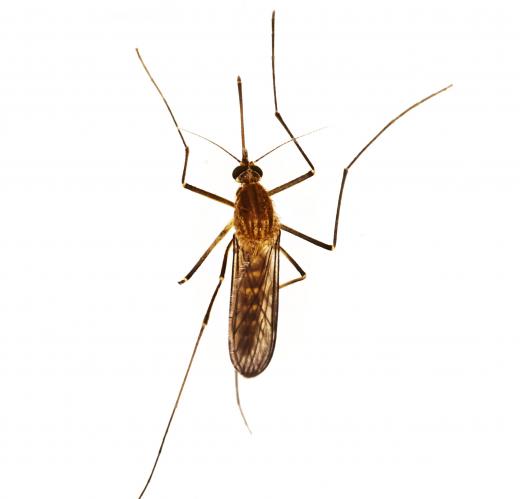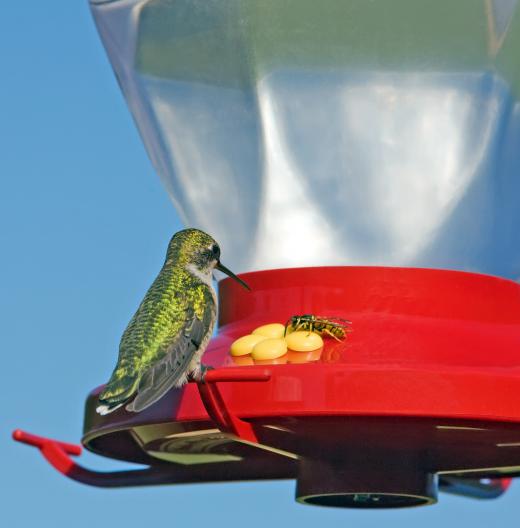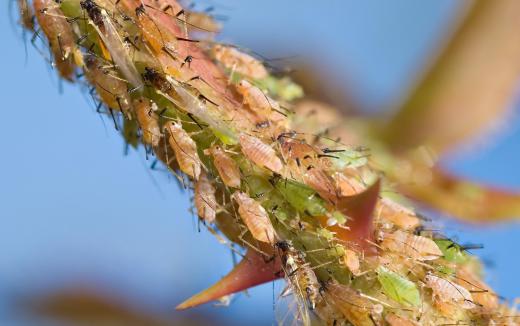What is Fluid Feeding?
 Michael Anissimov
Michael Anissimov
Fluid feeding is one of five major feeding modes used by organisms. The others are filter feeding, deposit feeding, bulk feeding, and phagocytosis.
Fluid feeding is defined as getting your nutrients by consuming the fluids of another organism. Animals which practice fluid feeding include hummingbirds, spiders, aphids, vampire bat, ticks, mosquitos, and leeches. Except for hummingbirds, that's veritably a rogue's gallery of reviled organisms.

Many fluid feeders justifiably have a bad reputation. Although the "fluid" in question may be botanical in origin, when it involves animals, the fluid is blood. So many fluid feeders are bloodsuckers. But fluid feeding is obviously a successful mode, and has probably been around since insects first crawled onto land about 428 million years ago, during the Devonian period.

Fluid feeders need some way to pierce the protective wall (skin or plant walls) getting in the way of the fluid, then some proboscis-like appendage for sucking out all the fluids. Aphids are specialized in doing this with plants, which is why they can be found in such numbers on certain plants, especially those that produce an abundance of sweet fluid.

Hummingbirds, the smallest bird with the highest metabolism, are fluid feeders of flowers. Hummingbirds are a remarkable animal: they're the only bird capable of flying backward, and controlling vertical and lateral movement with such precision. Their long beaks are used to drink the nectar out of flowers, an excellent example of fluid feeding. Hummingbirds beat their wings between 15 and 80 times per second, and their metabolism is so fast that they are hours away from starving at any given moment.
The most despised fluid feeders are those that feed on human blood, spreading infections and some of the worst diseases. Pliny the Elder called blood-sucking ticks "the foulest and nastiest creatures that be." They spread various diseases, including Lyme disease, which can be fatal if left untreated. Mosquitos annoy us with their buzzing and spread malaria, which afflicts half a billion people every year and kills between one and three million.
Although fluid feeding is not a particularly common method of feeding, we see that animals that use this feeding mode have a diverse range, from foul to beautiful.
AS FEATURED ON:
AS FEATURED ON:













Discussion Comments
I wonder if they ever categorize humans as being fluid feeders. There are definitely people who have to live off gastrostomy tubes because they can't eat with their mouths for some reason. You can exist for a long time that way, but it isn't a very pleasant way to get your nourishment.
@umbra21 - That's not true of every animal that is a fluid feeder though. They mention vampire bats in the article and they don't suck up blood, even though their name makes it sound like they would.
It's actually even more creepy what they do. They will use their teeth to chip open a wound in an animal, and their saliva will make sure the wound is numb and the blood keeps flowing. Then they lap up the blood.
They don't actually drink all that much blood, but they can be dangerous just because the animal or person might keep bleeding for a long time and might attract more of the bats.
There are plenty of other animals that feed off fluids, although most of them happen to be insects. Wasps, for example, will feed off nectar and other liquids and are often pests when introduced to the wrong area because they will force out other creatures that eat the same food.
There are other birds that will drink nectar as well as hummingbirds, although most of them will eat other things as well, like insects and seeds. You can often tell if an insect or animal is a fluid feeder because they will have a very long nose or beak that can be used as a kind of straw to suck up the fluids.
Post your comments